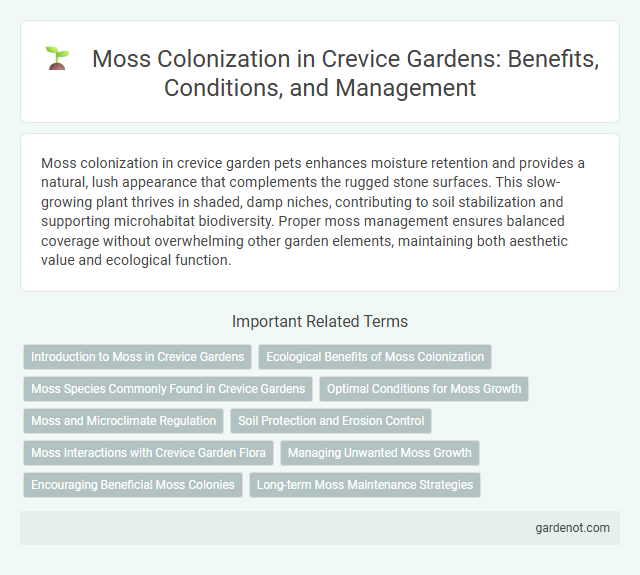Moss colonization in crevice garden pets enhances moisture retention and provides a natural, lush appearance that complements the rugged stone surfaces. This slow-growing plant thrives in shaded, damp niches, contributing to soil stabilization and supporting microhabitat biodiversity. Proper moss management ensures balanced coverage without overwhelming other garden elements, maintaining both aesthetic value and ecological function.
Introduction to Moss in Crevice Gardens
Mosses thrive in crevice gardens due to their ability to colonize shaded, moist microhabitats within stone gaps and narrow soil pockets. Their lightweight spores disperse easily, allowing rapid establishment on rough surfaces and minimal soil. This natural colonization enhances biodiversity by stabilizing soil, retaining moisture, and creating a lush, green carpet that complements the rugged texture of crevice gardens.
Ecological Benefits of Moss Colonization
Moss colonization in crevice gardens enhances soil moisture retention and reduces erosion by stabilizing the substrate within narrow rock fissures. This natural ground cover supports biodiversity by providing habitat for microfauna and facilitating nutrient cycling in otherwise sparse environments. Mosses also improve air quality through carbon sequestration, contributing to the overall ecological balance of crevice garden ecosystems.
Moss Species Commonly Found in Crevice Gardens
Moss species commonly found in crevice gardens include Bryum capillare, Tortula muralis, and Grimmia pulvinata, which thrive in the shaded, moist microhabitats created by stone crevices. These mosses play a crucial role in stabilizing soil and retaining moisture within the narrow spaces, facilitating further plant colonization. Their ability to tolerate desiccation and varying light conditions makes them ideal pioneer species in crevice garden ecosystems.
Optimal Conditions for Moss Growth
Moss colonization in crevice gardens thrives under consistently moist conditions, shaded environments, and acidic substrates with a pH between 5.0 and 6.5. The presence of porous, rough-textured surfaces facilitates spore attachment and retention of humidity essential for moss establishment. Low nutrient availability and minimal disturbance further promote dense moss growth, enhancing the garden's microhabitat diversity.
Moss and Microclimate Regulation
Moss colonization in crevice gardens plays a crucial role in microclimate regulation by retaining moisture and moderating temperature fluctuations within the gaps between rocks. These bryophytes create a humid microenvironment that supports biodiversity and reduces evaporation rates, enhancing the garden's overall resilience to drought. Moss mats also act as natural insulators, stabilizing substrate conditions and promoting the establishment of other plant species in the crevices.
Soil Protection and Erosion Control
Moss colonization in crevice gardens plays a crucial role in soil protection by establishing a dense, moisture-retentive mat that reduces surface runoff and minimizes soil erosion. Its root-like rhizoids bind soil particles together, enhancing substrate stability on steep or rocky surfaces. This natural erosion control mechanism supports long-term soil conservation and promotes healthy plant growth within crevice ecosystems.
Moss Interactions with Crevice Garden Flora
Moss colonization in crevice gardens enhances biodiversity by forming symbiotic relationships with surrounding flora, improving soil moisture retention and nutrient cycling. These bryophytes create microhabitats that support seedling establishment and protect delicate plant roots from erosion. Moss interactions with crevice garden plants contribute to ecosystem stability, promoting resilient and thriving urban green spaces.
Managing Unwanted Moss Growth
Managing unwanted moss growth in crevice gardens requires balancing moisture levels and sunlight exposure, as excessive dampness and shade promote moss colonization. Regular removal by gentle scraping or using a soft brush can prevent moss from overtaking stone surfaces and plants. Applying environmentally safe moss inhibitors helps control growth without harming the delicate microhabitat of the crevice garden.
Encouraging Beneficial Moss Colonies
Encouraging beneficial moss colonies in crevice gardens involves creating optimal moisture and shade conditions that support moss spores' growth and attachment. Selecting native moss species adapted to local climate enhances colonization success and ecological balance. Regular monitoring and minimal disturbance allow moss to establish robust colonies, improving soil stability and moisture retention within the garden crevices.
Long-term Moss Maintenance Strategies
Long-term moss maintenance in crevice gardens relies on regulating moisture levels and ensuring adequate shade to promote healthy moss colonization. Periodic removal of debris and invasive plants prevents competition and supports moss proliferation in narrow spaces. Routine monitoring of pH and nutrient availability optimizes substrate conditions, sustaining moss growth over time.
Moss colonization Infographic

 gardenot.com
gardenot.com